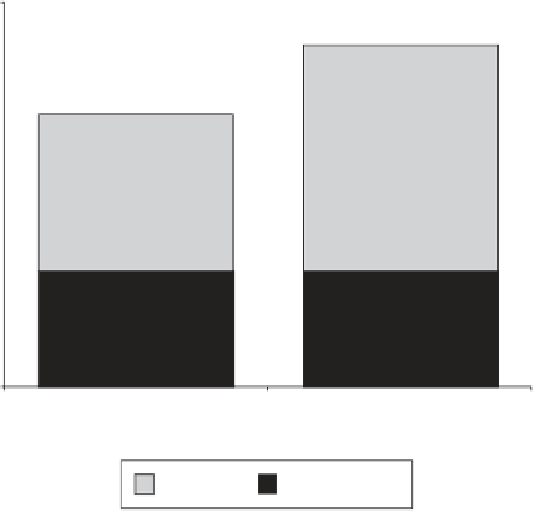Agriculture Reference
In-Depth Information
improving environmental sustainability of the
US ruminant livestock industries over the past
century (Capper
et al
., 2009; Capper, 2011a).
None the less, the mechanisms by which pro-
ductivity improves, and the management sys-
tems or production practices implemented to
promote productivity gains, vary significantly
between industries and species.
impact of increased milk yield may be exempli-
fied by comparing resource use and GHG emis-
sions from US dairy production in 1944 and
2007 as described by Capper
et al
. (2009).
The US dairy herd peaked at 25.6 million
cows in 1944, with an average annual milk yield
per cow of 2074 kg and an annual national pro-
duction of 53.0 billion kg milk (Capper
et al
.,
2009). At this time, dairy herds characteristi-
cally contained six cows that were fed a pasture-
based diet with occasional supplemental feed.
Artificial insemination was in its infancy and
neither antibiotics nor supplemental hormones
were available for animal use. By contrast, the
2007 US dairy herd contained 9.2 million cows
producing 84.2 billion kg milk (average yield
9193 kg year
−1
). These productivity gains were
facilitated by improvements in management,
nutrition, genetics and the application of new
technologies and are a proof of concept for the
dilution of maintenance effect reducing both
resource use and GHG emissions through a
decrease in dairy population size. Compared
with 1944, the 2007 US dairy industry required
only 21% of the dairy population to produce a
set quantity of milk (Fig. 11.2). Consequently,
feedstuff use was reduced by 77%, land use by
90% and water use by 65% per unit of milk.
Manure output per unit of milk produced in
The Dilution of Maintenance Concept
within Ruminant Production
Improving yield per animal is the most widely
understood productivity measure. If we increase
the milk yield of a lactating dairy cow from 22 to
31 kg day
−1
, the maintenance energy requirement
(75 MJ day
−1
) does not change, but is diluted out
over more units of production and thus reduced
from 42% to 34% of total daily energy needs. Con-
comitantly, the energy required per kg of milk is
reduced from 8.1 to 7.2 MJ kg
−1
(Fig. 11.1). As milk
yield increases, fewer lactating cows are requi-
red to produce a set amount of milk and the
number of associated support animals (dry cows,
replacement heifers, bulls) in the population
decrease, thus the total population maintena-
nce requirement is reduced. The environmental
250
7.2 MJ ME kg
-1
milk
200
8.1 MJ ME kg
-1
milk
150
66%
58%
100
50
42%
34%
0
22 kg day
-1
31 kg day
-1
Milk yield (kg day
-1
)
Lactation
Maintenance
Fig. 11.1.
The impact of increasing daily milk yield on the proportion of daily energy used for
maintenance versus lactation in dairy cattle - the 'dilution of maintenance' effect.





